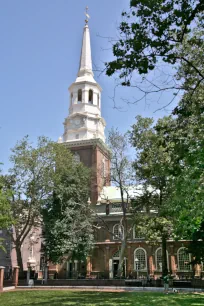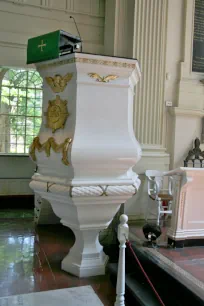Christ Church is a historic church built in the eighteenth century in Georgian style. It is one of the most important churches from the colonial era; many prominent figures of the American Revolution attended services here.


In 1680 William Penn founded the Province of Pennsylvania with the aim of providing a refuge for the Quakers, a religious movement. Penn, a Quaker himself, decided people from other religions were welcome in his province, including Anglicans, who built a small wooden church in 1697. In 1726 the congregation had outgrown the church and plans were made for the construction of a larger church.
The Church
The new church was designed in Georgian style and modeled on Christopher Wren’s London churches. Construction started in 1727 under the supervision of John Kearsley. Construction continued until 1744. By then the church was completed except for the steeple, which was added later, in 1751-1754. Ben Franklin sponsored a series of lotteries in an effort to gather funds for the completion of the steeple. It topped out at a height of 196 feet (60 meters), rising high above colonial Philadelphia. The steeple still contains the original bells that were cast in England.
The baptismal font also originates from England. It is the font in which William Penn was baptized in 1644. In 1697, it was transported from the All Hallows-by-the-Tower church in London to Philadelphia, where it was placed in the new Christ Church.

The church, which was dubbed “The Nation’s Church”, was a place of worship for many revolutionaries and patriots, including fifteen signers of the Declaration of Independence. Benjamin Franklin and future presidents Thomas Jefferson and George Washington are some of the most famous figures who attended the church. Bronze plaques mark the pews where they used to sit.
Christ Church Burial Ground
The church’s burial ground, at the corner of Arch Street and Fifth Street, is the last resting place for many American revolutionaries. The most famous is Benjamin Franklin. You can easily spot his gravestone since it is often covered with pennies, a reference to a phrase he coined: “A penny saved is a penny earned”.

